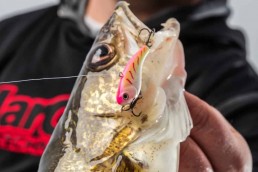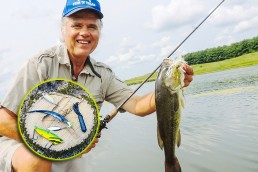Excite the Bite by Drawing in Fish with Search Baits
SHARE THIS POST
The summer of 2000 was my formative attempt at higher education in the fishing world. I was a natural resources tech and mapmaker working inside of Yellowstone National Park by day, and roaming the many nearby streams, rivers, lakes and ponds by evening. Both were in search of trout, and some extra bucks. I took occasional overflow guide trips from a buddy who taught me most of what I know about the subject and who also helped me shape some fish-finding strategies on the ice or open water.
It was a number 14 Coachmen fly that convinced me on most days I could scour the local streams for a few takers, and then examine the fish’s stomach contents to unlock secrets to the bite. As an attractor pattern, the Royal Coachmen was the best fly often, even with natural offerings and a persistent hatch. Though it was on trout streams throughout Wyoming and Montana, search baits and a specific method to using them would become forever woven into my approach.
I classify search baits loosely, but include any lure that dives quickly, gives off good vibration and is visually appealing from a distance. The idea in using them is to cover water, both above ice and below. While you’re drilling up new icy real estate and covering ground, the bait is actively calling fish from far outside the cone angle of your sonar, putting the offering in more faces, which leads to more bites. From the boat, your casts and retrieve constantly shop your jig to new fish. On ice, drilling holes and fishing aggressively with search baits help you cover the same water.
Using flashy baits and fishing fast are no innovation among anglers, but on ice there seems to be a growing apathy toward the approach. As drop-down wheelhouses become more prevalent across the icescape and more comfortable shelters are the norm rather than the exception, so too goes our interest in drilling up the hard water. Don’t get me wrong, I’m a fan of both styles of fishing, but it seems that a generation bred on Dave Genz’s style of mobility has given way to some more stationary means of fishing. As it turns out, no matter what method you prefer search baits for ice make sense for both the hole-hopper and permanent ice-dweller.
For ice, we’re lucky in that our environment is far more controlled. There’s no motion or movement above ice in the form of a rocking boat or wavy surface, and fishing streams, rivers or other moving waters is far less common. In many states, we’re also lucky to be able to use multiple lines so that search baits don’t actually need to catch the fish, but just draw them in.
Are you enjoying this post?
You can be among the first to get the latest info on where to go, what to use and how to use it!
For fishing inside hard-houses, I prefer an active set. For all the rattle reels, deadsticks or bobber rods, there’s usually at least one person trying to ring the dinner bell. Rattling spoons, blade baits, lipless crankbaits with rattles, Jigging Raps and even large spoons ripped aggressively, are the order of the day. Excite the bite by drawing in fish of all shapes and sizes, hoping that even if they’re not interested in what you’re jigging, they’ll eat one of the other offerings throughout the house.
Start higher in the water column than you’d think, giving fish “room” to show up below the bait on your sonar. If you jig that aggressively in the strike zone you’ll see far fewer fish on the screen and catch even less. Once the mere flicker of a mark indicates a fish toward the outside edge of your sonar’s cone angle, your whole approach changes from mass attraction to seductive appeal. At this point, everything goes in slo-mo as you try to make a non-finesse bait look more subtle than its design. Keep others around you aware of what’s going on, provided they’re not going to drop the biggest bait they have and start yo-yoing it. Fish that are unwilling to eat a single aggressive offering are typically looking for live bait, a small jig and plastic combination or some other smaller, less obtrusive bait. Bombarding them with more vibration and flash is rarely the answer.
Out on open ice you’re often forced to fish a single rod, and provided fish are active, this is usually a good thing. With first ice being a prime example, you want to cover ice, assuming that there are active fish likely biting somewhere. Whether it’s panfish or walleyes, aggressive fish are catchable with search baits—and if you’re not seeing fish you need to be moving to find them. If you’re seeing them and not catching, you may need to fish as a team, dropping other baits once you’ve attracted them to that area. More often, you can stick with the same search bait but need to slow down your approach even further by pausing more frequently, slowly lifting or by rocking horizontal baits back and forth.
A rocking motion, when possible for horizontal style lures, usually seals the deal as fish approach but are hesitant. Think of the No. 2 pencil trick where you hold it in the middle between your thumb and forefinger, waving it up and down until it appears to be made of rubber. It can be tricky to make your bait do that, but the top training tool available is most definitely a quality underwater camera. Take some time this season to study different baits on camera so that you can fish loud and fast to bring them in. Then, make the same bait come alive with the most enticing slow movements and bait-like twitches.
MWO
SHARE THIS POST
You may also like...
Did you enjoy this post?
You can be among the first to get the latest info on where to go, what to use and how to use it!
Joel Nelson
MidWest Outdoors works with more than 200 outdoor experts each year, who contribute articles based on their areas of expertise. MidWest Outdoors magazine offers more fishing and hunting articles than any other publication!


